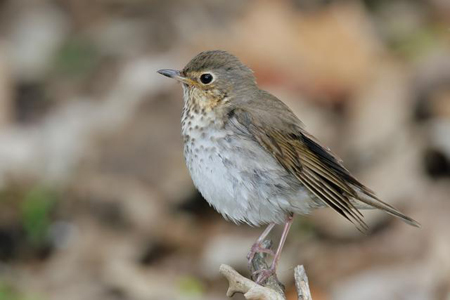
Bill recorded 38 Swainson's Thrush on the night of September 10-11.
Credit: Jeff Nadler
For those waiting to hear whether the predictions made by Bill Evans of a grand nocturnal migration of Boreal birds came true last week, we post below Bill’s update. Check out especially the thermal video image of nocturnally migrating birds-- the birds look like slow shooting stars in the video.
This from Bill:
I begin by stating simply that if anyone ever substantiates a future nocturnal vertebrate migration over interior northeastern US (in the first two weeks of September) bigger than what occurred the night of Sep 10-11, 2010.....I will buy fine ale for the whole nfc listserv membership at a pub of consensual choice somewhere on the planet. So, for those who have an ear to hear and an eye to see in this manner, take note of future fall migrations over northeastern US in case of cashing in on my offer. I wager, given the rarity of such large nocturnal migrations in the past 20 years, and the crushing inertia of human civilisation, that a flight the density and breadth of Sep 10-11 2010 will not happen again in our lives across interior northeastern USA. If so, I will be singing "kumbaya" in reverance.
As I recall, it was about a week in advance that I began preparations to surf the then subtley-evident behemoth wave. Allocation of spousal
attention was reduced; the kids welfare rationalized circularly by my pending documentary actions. We walk a thin line of sanity in this nocturnal migration preoccupation, especially so during wartime and amidst other human tragedies on our nerve within a keystroke. But we prevail in the bigger picture, imprinting earth with our natural history activities, respectfully & nonetheless.
The pulse of migration over central New York State on the night of Sep 10-11 rocked the relative historic framework. My initial calculations were off
(http://www.birdingonthe.net/mailinglists/NFCL.html#1283970775), but you only lose in such events when you miss them. The flight happened two nights later than I thought, and Catharus fuscescens y Wilsonia pusilla flight calling turned out to be normal for the time of year, instead of the higher numbers and proportions I had guessed. But the number of migrants aloft burst forth with full remnant ebullience. That density was nature-born and the species composition a delightfully telling ancient echo. The flight is now just a memory for a few of us, but indicative records remain:
Radar reflectivity and velocity images from the night are available for download for another 24 hours or so at:
http://www.rap.ucar.edu/weather/radar/.
Specifically, the NEXRAD records from Albany, Watertown, Binghamton, and Buffalo, NY along with State College, PA show sign of sustained 28+ dBZ biological reflectivity crossing the breadth of interior NY (Albany to Buffalo) and moving southward across central PA.
The link below leads to a thermal image video I made during a period of peak passage in the flight (11:15-12:00 EDT) from 610 m asl at the Connecticut Hill Wildlife Management Area (15 km east of Ithaca, NY, US). The flight activity shown in the video likely represents the lower portion of 28+ dBz radar reflectivity that was occurring on this clear sky night -- targets were noted passing at a rate >100 per 5 minute period. This thermal video was made with a rented FLIR P65 camera with a 23-degree lens. The camera was pointed vertically toward the sky and positioned so that birds heading from the NNE toward the SSW would appear heading in straight line vertical motion from the bottom to the top of the screen of view:
Anne Klingensmith & family operated an acoustic monitoring station in Alfred, NY during the flight from 8PM to 6AM. Anne indicated to me that the Old Bird tseep detector extracted more than 1000 flight calls of warblers and sparrows during the ten hours. This is one of the highest clear night tseep call totals ever documented by this station, which has been in operation for 20 fall migration seasons. This calling is estimated to be largely from birds migrating within 300 m of the ground. Anne carried out a preliminary species analysis and reported 15 Wilson's Warbler flight calls among the 1000+ tseep notes (~1.5%). The acoustic data from this Alfred, NY station are planned to be put online at Oldbird.org in the near future.
I ran an acoustic monitoring station for five hours from 9PM-2AM at my house near Ithaca, NY (~500 m asl), which is not the best location in the area to record flight calls during such relatively high altitude migration events. I logged 219 tseep notes of which 5 were from Wilson's Warblers (~2.3%). I also ran the Old Bird Thrush detector and in spectrographic analysis using GlassOFire I noted the following species' flight calls: Swainsons Thrush 38, Rose-breasted Grosbeak 28, Veery 14, Gray-cheeked Thrush 0, and about 30 unknown thrush type flight calls. This composition is typical for Sep 10 in central NY except that I would have expected a few Gray-cheekeds in the mix.
In signing off I reiterate that for the diligently tuned I offer a chance, albeit I think a very small one, for free beer & a joyous occasion. Regards and best wishes for the remainder of the fall 2010 migration season,
Bill E

